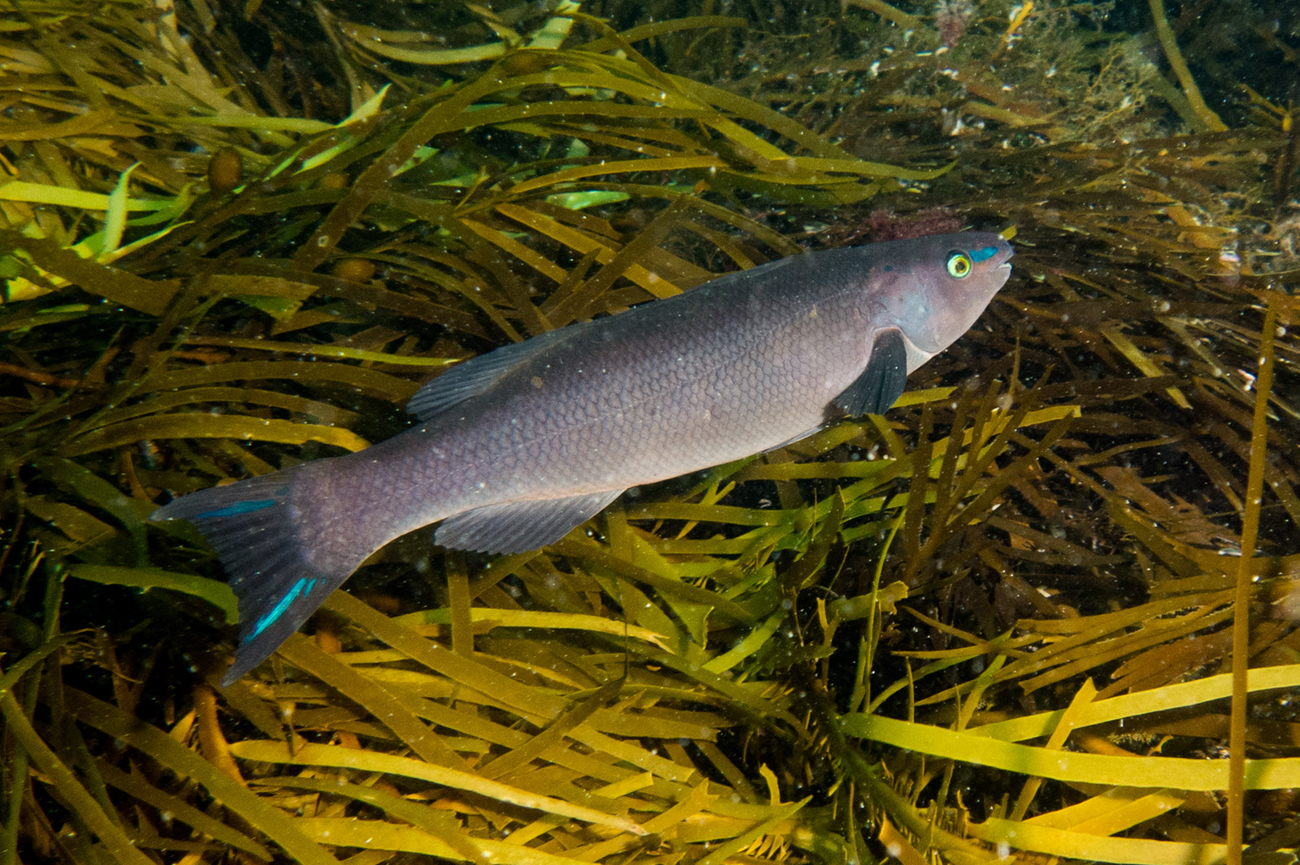- Classification
- ACTINOPTERYGII
- PERCIFORMES
- LABRIDAE
- Olisthops
- cyanomelas
Herring Cale, Olisthops cyanomelas (Richardson 1850)

A male Herring Cale, Olisthops cyanomelas, at Wilsons Promontory, Victoria, February 2017. Source: John Turnbull / Flickr. License: CC by Attribution-NonCommercial-ShareAlike
Summary:
Like most wrasses, this species changes both sex and colour throughout its life. Juveniles are greyish to brownish above, yellowish below, with dark brown blotches, spots and lines, and a broken pearly stripe on the side. Females are brown, darker above, with narrow blue wavy lines on the head; each scale with bluish white spot, fins brown with wavy blue lines. Males are pale blue to almost black with bright blue lines along the margins of the caudal fin, along the leading edge of the pectoral fin and on the snout.
Herring Cale have teeth in both jaws fused into a parrot-like beak with serrate edges.
This species was previously known as Odax cyanomelas.
Video of a female Herring Cale amongst kelp at Currarong, Jervis Bay, New South Wales.
Herring Cale have teeth in both jaws fused into a parrot-like beak with serrate edges.
This species was previously known as Odax cyanomelas.
Video of a female Herring Cale amongst kelp at Currarong, Jervis Bay, New South Wales.
Cite this page as:
Dianne J. Bray, Olisthops cyanomelas in Fishes of Australia, accessed 06 Jul 2025, https://fishesofaustralia.net.au/home/species/301
Herring Cale, Olisthops cyanomelas (Richardson 1850)
More Info
|
Distribution |
Widespread in southern Australia from Angourie Point, northern New South Wales, to the Houtman Abrolhos, Western Australia, and around Tasmania. Inhabits inshore rocky areas especially amongst kelp in the surge zone. Occurs in kelp forests, along exposed rocky coasts usually with brown macroalgae, and in Amphibolis griffithii seagrass beds. It is one of the most frequently encountered fishes on exposed rocky shorelines of the south coast, although is seen in low numbers. |
|
Features |
Dorsal fin XVI-XVIII, 9-11; Anal fin II-III, 9-11; Caudal fin 11-13; Pectoral fin 12-13; Pelvic fin I, 4; Lateral line scales 47-54. Body moderately shallow (19-25% SL), elongate, somewhat compressed; caudal peduncle moderately long and deep (caudal peduncle depth 40-60% caudal peduncle length). Head moderately small (24-31% SL), snout short (23-34% HL), rounded; eyes moderately small (14-23% SL); mouth small (upper jaw length 20-25% HL), horizontal, reaching nearly to below front edge of eye; teeth completely fused into pavement like beak. Scales moderately small, cycloid, covering body but none of head except for small patch high on opercle, predorsal scales reaching forward to above posterior edge of preopercle; lateral line nearly straight but with low dorsal curve above pectoral fin. Single dorsal fin with long base and deep notch between spinous and soft ray portions; anal fin opposite and similar to soft portion of dorsal; caudal fin slightly forked in juvenile, broadly lunate in adults. Pectoral fins with upper rays longest. Pelvic fins short, arising slightly behind and below pectoral fin origin. |
|
Colour |
Juveniles are greyish to brownish above, yellowish below, with dark brown blotches, spots and lines, and a broken pearly stripe on the side. Females are brown, darker above, with narrow blue wavy lines on the head; each scale with bluish white spot, fins brown with wavy blue lines. Males are pale blue to almost black with bright blue lines along the margins of the caudal fin, along the leading edge of the pectoral fin and on the snout. |
|
Feeding |
Herbivore - feeds on the kelp, Ecklonia radiata. |
|
Fisheries |
Although relatively large, the Herring Cale is not often taken by rod and reel because of its preference for feeding on algae. |
|
Species Citation |
Olisthops cyanomelas Richardson, 1850, Proc. Zool. Soc. London 18: 75, pl. 3, figs .1-2. Type locality: King Georges Sound, Western Australia. |
|
Author |
Dianne J. Bray |
Herring Cale, Olisthops cyanomelas (Richardson 1850)
References
Andrew, N.L. & Jones, G.P. 1990. Patch formation by herbivorous fish in a temperate Australian kelp forest. Oecologia 85: 57-68.
Clements, K.D., Alfaro, M.E., Fessler, J.L. & Westneat, M.W. 2004. Relationships of the temperate Australasian labrid fish tribe Odacini (Perciformes; Teleostei). Molecular Phylogenetics and Evolution 32: 575–587.
Gomon, M.F. & Paxton, J.R. 1985. A revision of the Odacidae, a temperate Australian-New Zealand labroid fish family. Indo-Pacific Fishes 8: 57pp.
Gomon, M.F., Bray, D.J. & Kuiter, R.H. 2008. Fishes of Australia’s Southern Coast. Reed New Holland, Museum Victoria, Chatswood, NSW, Australia.
Jones, G.P. & Andrew, N.L. 1990. Herbivory and patch dynamics on rocky reefs in temperate Australasia: the roles of fish and sea urchins. Australian Journal of Ecology 15: 505-520.
MacArthur, L.D. & Hyndes, G.A. 2001. Differential use of seagrass assemblages by a suite of odacid species. Estuarine, Coastal and Shelf Science 52: 79-90.
Russell, B., Clements, K.D., Choat, J.H., Rocha, L.A., Myers, R., Lazuardi, M.E., Muljadi, A., Pardede, S. & Rahardjo, P. 2012. Olisthops cyanomelas. The IUCN Red List of Threatened Species 2012: e.T190679A17774029. http://dx.doi.org/10.2305/IUCN.UK.2012.RLTS.T190679A17774029.en . Downloaded on 19 October 2015.
Shepherd, S.A. & Baker, J.L. 2008. Investigator Group Expedition 2006: Flexible foraging ecology of a temperate herbivore, the herring cale, Olisthops cyanomelas, in South Australia. Transactions of the Royal Society of South Australia 132: 147-162.
Shepherd, S.A., Edgar, G.J. & Barrett, N.S. 2005. Reef fishes of the Althorpe Islands and adjacent coasts of central South Australia. Transactions of the Royal Society of South Australia 129: 183-192.







